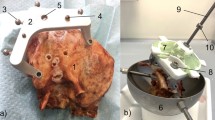Abstract
Purpose
To introduce a novel microstereotactic frame, called the Microtable, consisting of a tabletop that mounts on bone-implanted spherical markers. The microtable is customized for individual patient anatomy to guide a surgical instrument to a specified target.
Methods
Fiducial markers are bone-implanted, and CT scanning is performed. A microtable is custom-designed for the location of the markers and the desired surgical trajectory and is constructed using a computer-numerical-control machine. Validation studies were performed on phantoms with geometry similar to that for cochlear implant surgery. Two designs were tested with two different types of fiducial markers.
Results
Mean targeting error of the microtables for the two designs were 0.37 ± 0.18 and 0.60 ± 0.21 mm (n = 5). Construction of each microtable required approximately 6 min.
Conclusions
The new frame achieves both high accuracy and rapid fabrication. We are currently using the microtable for clinical testing of the concept of percutaneous cochlear implant surgery.
Similar content being viewed by others
References
Maurer CR Jr, Fitzpatrick JM, Wang MY et al (1997) Registration of head volume images using implantable fiducial markers. IEEE Trans Med Imaging 16: 447–462. doi:10.1109/42.611354
Woerdeman PA, Willems PWA, Noordmans HJ et al (2007) Application accuracy in frameless image-guided neurosurgery: a comparison study of three patient-to-image registration methods. J Neurosurg 106(6): 1012–1016. doi:10.3171/jns.2007.106.6.1012
Brown RA (1986) System using computed tomography as for selective body treatment. Patent No. 4,608,977, US Patent and Trademark Office (filed 1982, granted 1986)
Maciunas RJ, Galloway RL Jr, Latimer JW (1994) The application accuracy of stereotactic frames. Neurosurgery 35: 682–694. doi:10.1097/00006123-199410000-00015
Yu C, Apuzzo ML, Zee CS, Petrovich Z (2001) A phantom study of the geometric accuracy of computed tomographic and magnetic resonance imaging stereotactic localization with the Leksell stereotactic system. Neurosurgery 48: 1092–1099. doi:10.1097/00006123-200105000-00025
Bjartmarz H, Rehncrona S (2007) Comparison of accuracy and precision between frame-based and frameless stereotactic navigation for deep brain stimulation electrode implantation. Stereotact Funct Neurosurg 85: 235–242. doi:10.1159/000103262
Franklin RJ, Franck JI, Haer FC (2001) Customized surgical fixture. Patent No. 6,327,491, US Patent and Trademark Office (filed 1998, granted 2001)
Franck J, Konrad P, Franklin R et al (2002) STarFix: a novel approach to frameless stereotactic neurosurgery utilizing a miniaturized customized pretargeted cranial platform fixture–technical description, unique features, and case reports. Movement Disorders Society. In: Seventh international congress of parkinsons disease and movement disorder, Miami
Balachandran R, Mitchell J, Dawant BM, Fitzpatrick JM (2009) Accuracy evaluation of MicroTargeting™ platforms for deep-brain stimulation using virtual targets. IEEE Trans Biomed Eng 56(1): 37–44
Franck JI, Haer FC, Franklin RJ et al (2001) Instrument guidance for stereotactic surgery. Patent No. 6,298,262, US Patent and Trademark Office (filed May 2001, granted October 2001)
Henderson JM, Holloway KL, Gaede SE, Rosenow JM (2004) The application accuracy of a skull-mounted trajectory guide system for image-guided functional neurosurgery. Comput Aided Surg 9: 155–160. doi:10.1080/10929080500050249
Balachandran R, Mitchell J, Dawant B, Fitzpatrick JM (2007) Evaluation of targeting frames for deep-brain stimulation using virtual targets. In: IEEE international symposium on biomedical imaging: from Nano to Macro, 2007, pp 1184–1187
Labadie RF, Noble JH, Dawant BM et al (2008) Clinical validation of percutaneous cochlear implant surgery: Initial report. Laryngoscope 118(6): 1031–1039. doi:10.1097/MLG.0b013e31816b309e
Liu X, Cevikalp H, Fitzpatrick JM (2003) Marker orientation in fiducial registration. In: Proceedings SPIE Medical Imaging 2003, San Diego, CA, vol 5032. pp 1176–1185
Labadie RF, Choudhury P, Cetinkaya E et al (2005) Minimally-invasive, image-guided, facial-recess approach to the middle ear: Demonstration of the concept of percutaneous cochlear access in vitro. Otol Neurotol 26: 557–562. doi:10.1097/01.mao.0000178117.61537.5b
Warren FM, Balachandran R, Fitzpatrick JM, Labadie RF (2007) Percutaneous cochlear access using bone-mounted, customized drill guides: demonstration of concept in vitro. Otol Neurotol 28(3): 325–329. doi:10.1097/01.mao.0000253287.86737.2e
Noble JH, Warren FM, Labadie RF et al (2007) Determination of drill paths for percutaneous cochlear access accounting for target positioning error. In: Proceedings of Medical Imaging 2007, San Diego
Labadie RF, Balachandran R, Mitchell J et al (2009) Clinical validation study of percutaneous cochlear access using patient- customized, microstereotactic frames. Accepted for presentation at the 2009 AOS/COSM Spring Meeting Scientific Sessions, Phoenix, AZ, May 2009
Author information
Authors and Affiliations
Corresponding author
Rights and permissions
About this article
Cite this article
Labadie, R.F., Mitchell, J., Balachandran, R. et al. Customized, rapid-production microstereotactic table for surgical targeting: description of concept and in vitro validation. Int J CARS 4, 273–280 (2009). https://doi.org/10.1007/s11548-009-0292-3
Received:
Accepted:
Published:
Issue Date:
DOI: https://doi.org/10.1007/s11548-009-0292-3




